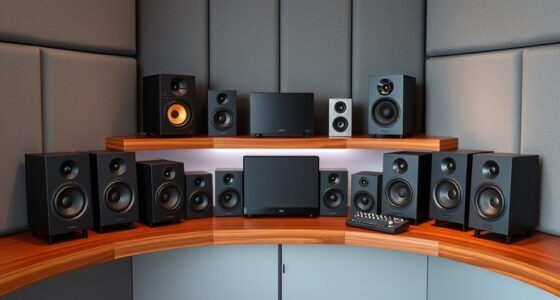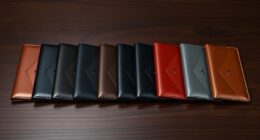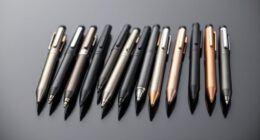If you’re looking for the best portable field recorders that deliver high-quality sound on the go, I’ve got you covered. Some top picks include the TASCAM DR-05XP, Zoom H4essential, and TASCAM Portacapture X8. These devices offer impressive audio fidelity, various microphone options, and long battery life. Whether you’re a musician, podcaster, or content creator, there’s a recorder to suit your needs. Keep checking out the full list to find the perfect match for your recording adventures!
Key Takeaways
- Look for recorders with 32-bit float technology to ensure high dynamic range and prevent clipping during loud recordings.
- Choose models with versatile microphone options, including built-in mics and external inputs like XLR and TRS for enhanced audio quality.
- Prioritize devices with long battery life (6 to 20 hours) for extended recording sessions in the field.
- Consider portability and size; compact and lightweight designs are ideal for on-the-go recording in various environments.
- Check for USB-C connectivity for easy file transfer and external power options to prolong recording time.
TASCAM DR-05XP Portable Handheld Field Recorder and USB-C Audio Interface
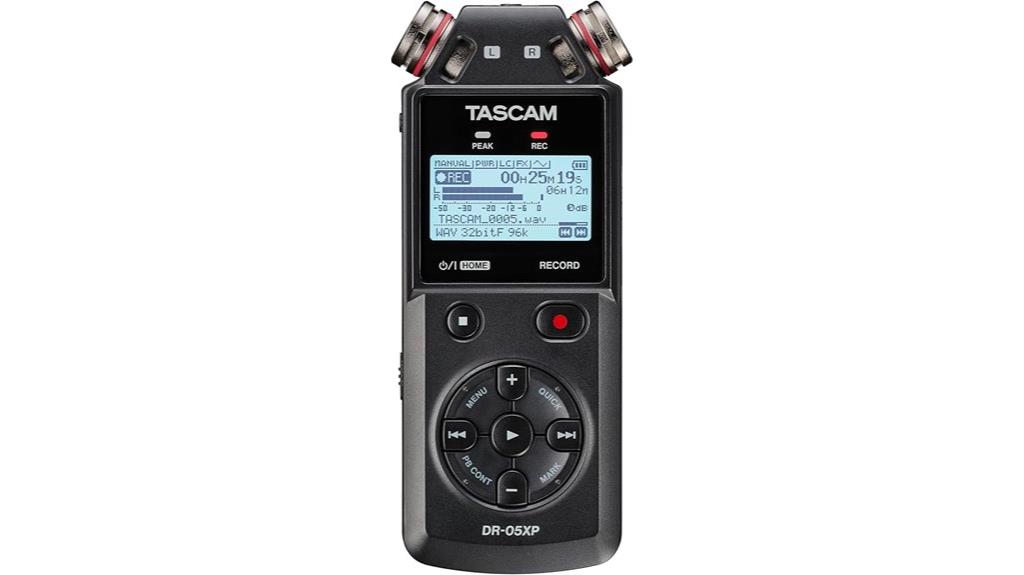
If you’re looking for a portable field recorder that excels in versatile audio capture, the TASCAM DR-05XP is an outstanding choice. With its omnidirectional microphones, it handles loud environments effortlessly, making it perfect for music, videos, and podcasts. I appreciate the flexible recording modes and the impressive battery life of up to 17.5 hours. While the tight microSD slot can be a hassle, the sound quality is superb. However, I’ve encountered some reliability issues, like recording without saving files. Overall, it offers great value and performance for musicians and content creators needing high-quality sound on the go.
Best For: Musicians, content creators, and anyone needing a portable audio recorder for high-quality sound capture in various environments.
Pros:
- Excellent sound quality with omnidirectional microphones that perform well in loud settings.
- Versatile recording modes including 32-bit float and multiple sample rates for flexible audio capture.
- Long battery life of up to 17.5 hours, allowing for extended recording sessions.
Cons:
- Reliability issues where recordings may not save properly, leading to potential frustration.
- Tight microSD card slot can make it difficult to install and remove the card frequently.
- User interface confusion, particularly with the record button requiring multiple presses to activate recording.
TASCAM DR-40X Portable Handheld Field Recorder
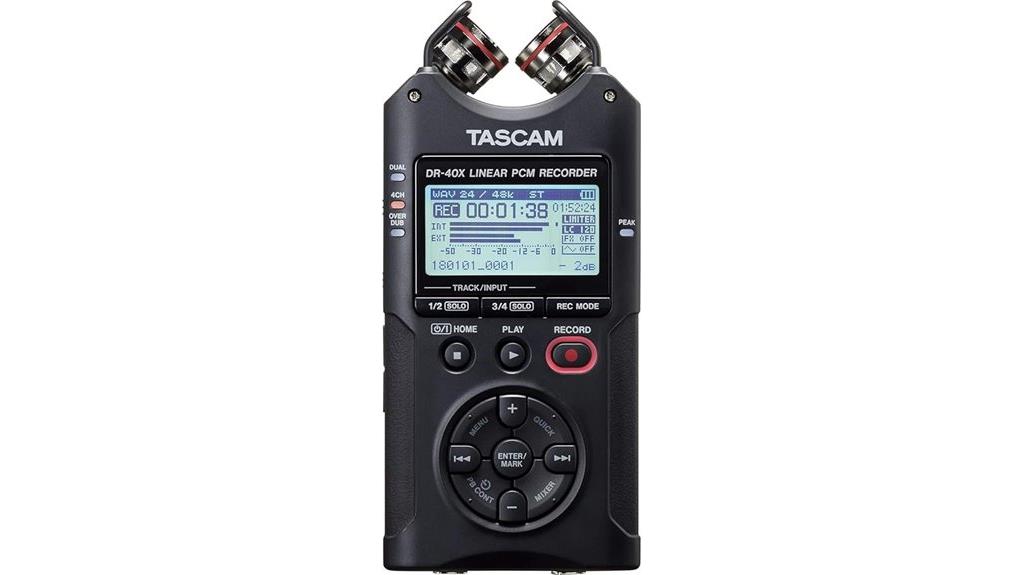
The TASCAM DR-40X Portable Handheld Field Recorder stands out for anyone looking to capture high-quality audio in a compact design, making it perfect for musicians, podcasters, and filmmakers alike. With its 4-track recording capabilities and dual adjustable microphones, I can easily produce professional-grade sound. The high-quality unidirectional stereo condenser mics allow for versatile recording in both A-B and X-Y configurations. Plus, the XLR/TRS inputs with +48V phantom power let me connect external mics seamlessly. Whether I’m recording music, video audio, or a podcast, this portable recorder is my go-to for reliable and stunning audio quality on the move.
Best For: The TASCAM DR-40X is best for musicians, podcasters, and filmmakers who need a portable and versatile audio recording solution.
Pros:
- High-quality recording with unidirectional stereo condenser microphones for clear sound.
- 4-track recording capability allows for complex audio projects including music and podcasts.
- Portable design makes it easy to use in field recording situations.
Cons:
- Limited battery life may require additional power sources for extended recording sessions.
- User interface can be complex for beginners to navigate efficiently.
- No built-in storage, necessitating the use of external SD cards for recording.
Zoom H4essential 4-Track Handy Recorder
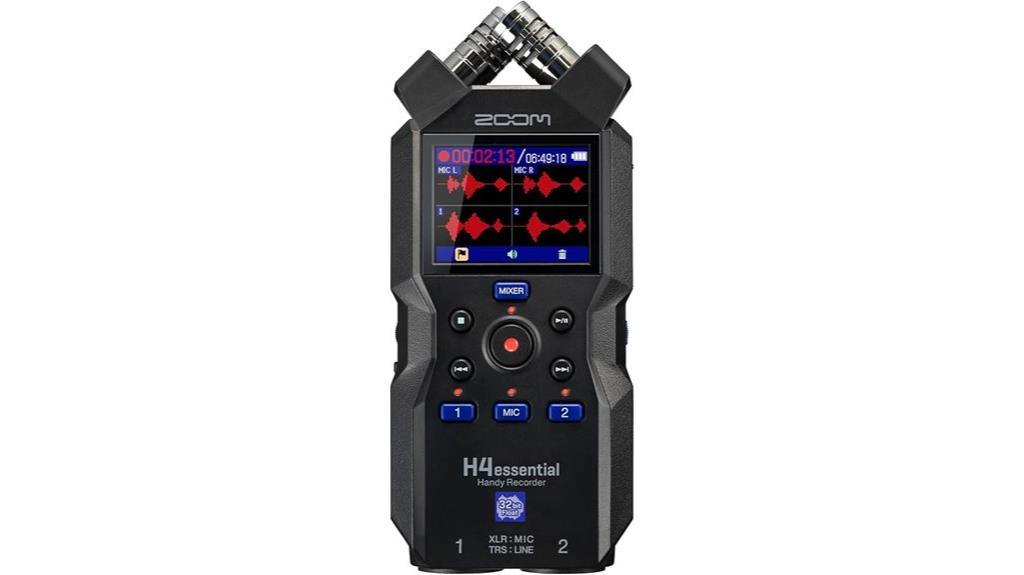
For musicians, podcasters, and filmmakers seeking high-quality audio on the go, the Zoom H4essential 4-Track Handy Recorder stands out with its impressive 32-bit float recording. This feature eliminates the hassle of gain adjustments and prevents clipping, allowing me to capture pristine audio in any environment. I love its XLR/TRS combo inputs and stereo mini-jack, making it easy to connect various microphones. Plus, with up to 20 hours of battery life, long recording sessions are a breeze. The clear 2.0 full-color LCD simplifies navigation, while its compact design means I can take it anywhere without a second thought.
Best For: Musicians, podcasters, and filmmakers seeking high-quality, portable audio recording solutions.
Pros:
- Exceptional 32-bit float recording eliminates gain adjustments and prevents clipping.
- Flexible connectivity options with XLR/TRS combo inputs and stereo mini-jack.
- Long battery life of up to 20 hours supports extended recording sessions.
Cons:
- May be overkill for casual users or simple recording tasks.
- The compact design might feel slightly bulky for some users.
- Limited onboard editing features compared to more advanced studio equipment.
Zoom H1n Stereo Handy Recorder
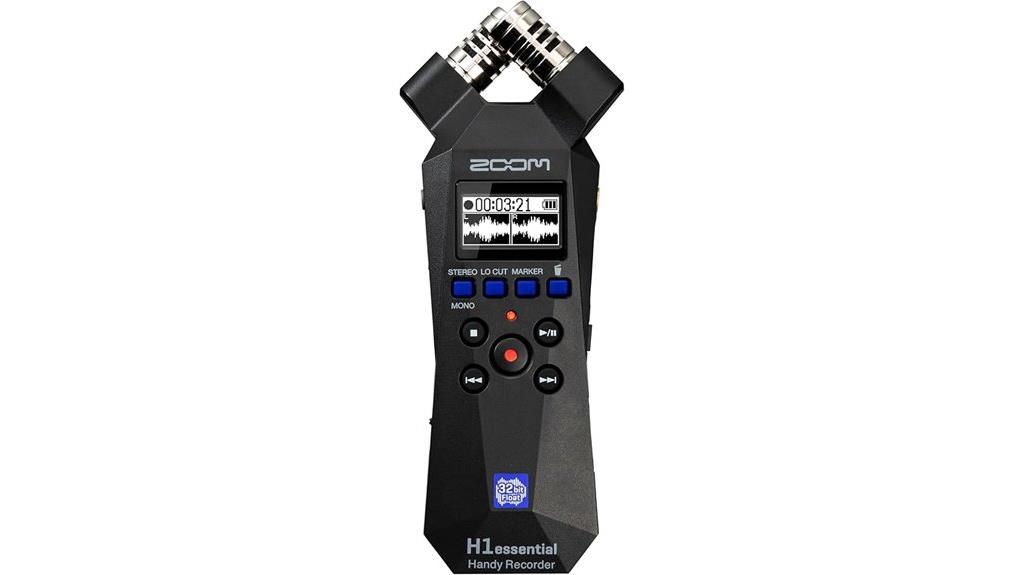
Compact and lightweight, the Zoom H1n Stereo Handy Recorder is perfect for anyone from musicians to podcasters seeking a reliable and portable recording solution. Measuring just 3.14 x 3.1 inches and weighing only 3.2 ounces, it fits easily in your hand or bag. Its built-in X/Y microphones capture stunning audio at up to 120 dB SPL, making it ideal for live performances and interviews. The USB-C port lets you connect it to various devices, while the user-friendly interface ensures straightforward operation. Despite some minor drawbacks, like the plastic build, this handy recorder delivers impressive sound quality, making it a must-have for creators on the go.
Best For: Musicians, podcasters, filmmakers, and content creators seeking a reliable, portable recording solution.
Pros:
- High-quality stereo recording with built-in X/Y microphones.
- Compact and lightweight design for easy transport and discreet use.
- USB-C compatibility allows connection to various devices, enhancing versatility.
Cons:
- Plastic build may require careful handling to avoid damage.
- Small screen and menu interface can be unintuitive for some users.
- Slow startup time (around 8-10 seconds) may be inconvenient in urgent situations.
TASCAM DR-10L Pro Field Recorder with Lavalier Microphone
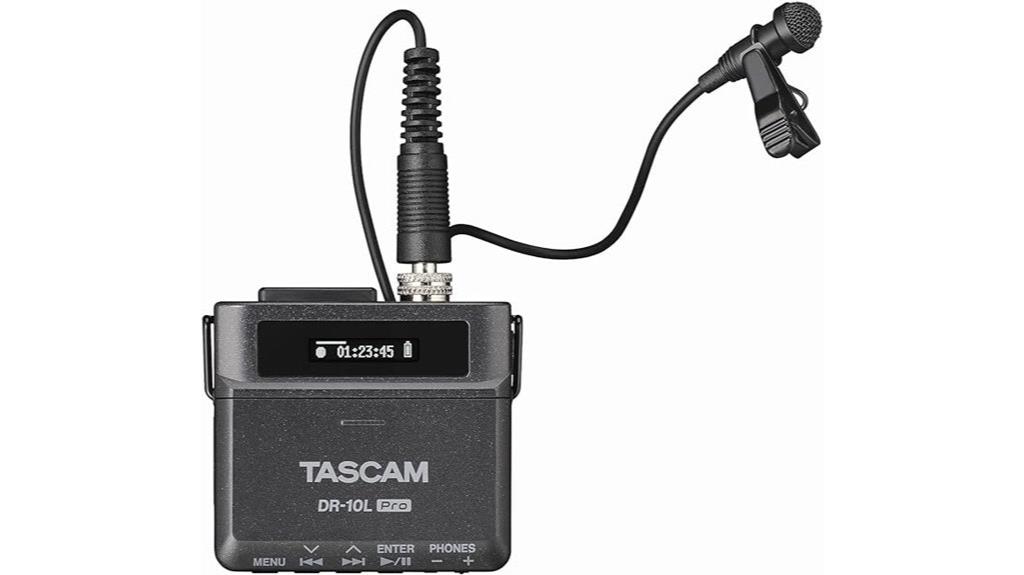
Designed with professionals in mind, TASCAM DR-10L Pro offers an exceptional solution for those needing high-quality audio capture in dynamic environments like interviews and video shoots. This compact recorder features 32-bit float recording, ensuring I capture every nuance from whispers to shouts. The included TM-10L lavalier microphone delivers clear sound, even amidst background noise. I appreciate the long battery life, giving me about 23 hours of recording time. With easy file transfers via microSD and USB-C, and compatibility with editing software like Audacity, the DR-10L Pro is a reliable companion for any audio project I undertake.
Best For: Professionals in video production and audio recording who require high-quality sound capture in dynamic environments.
Pros:
- Compact and lightweight design, making it easy to hide and transport.
- Long battery life of approximately 23 hours, ensuring extended recording sessions.
- 32-bit float recording allows for easy post-production adjustments without clipping.
Cons:
- Some users report issues with SD card compatibility, particularly with certain brands.
- The small screen may pose usability challenges for some users during operation.
- Occasional reliability issues, such as SD card read errors and internal battery malfunctions, have been noted.
Tascam DR-07X Stereo Handheld Digital Audio Recorder

The Tascam DR-07X Stereo Handheld Digital Audio Recorder stands out for its dual internal condenser microphones, making it ideal for musicians and podcasters who need to capture everything from soft vocals to loud instruments. I love how the adjustable unidirectional mics let me choose between A-B and X-Y configurations, ensuring the best sound for any scenario. The revamped user interface simplifies operations like recording and adding markers. With up to 17.5 hours of battery life from just two AA batteries, or USB power options, this recorder supports studio-quality audio and connects easily to my PC as a USB audio interface.
Best For: Musicians, podcasters, and content creators looking for a versatile and high-quality portable audio recording solution.
Pros:
- Dual internal condenser microphones capture a wide range of sound, from soft vocals to loud instruments.
- Adjustable unidirectional mics allow for customizable recording configurations (A-B and X-Y).
- Long battery life of up to 17.5 hours with two AA batteries and USB power options for extended use.
Cons:
- May require additional accessories for optimal use, such as tripods or external microphones.
- The user interface, while revamped, might still have a learning curve for beginners.
- Limited onboard editing features compared to more advanced recording software.
Zoom H1 XLR Handy Recorder with 32-Bit Float
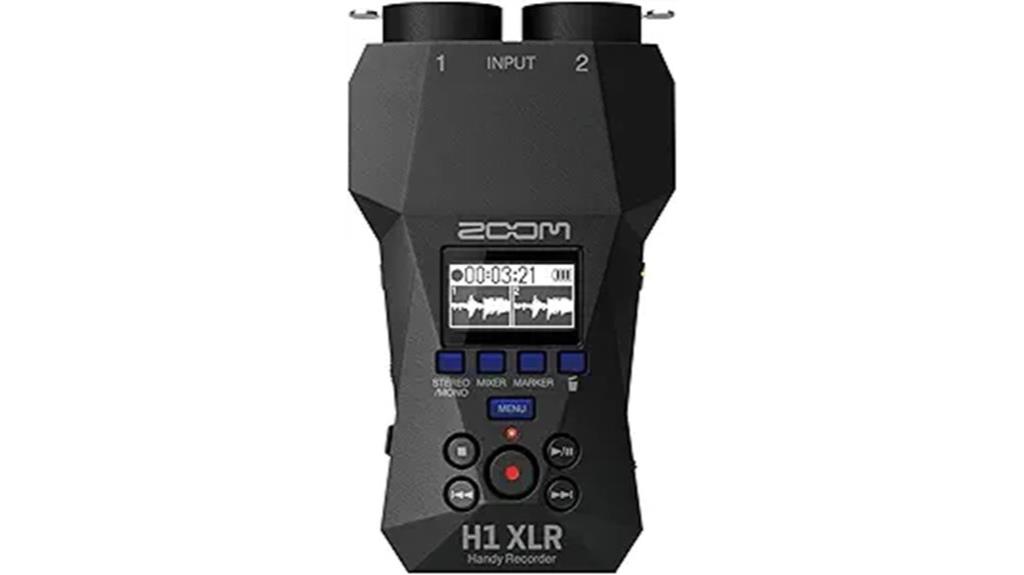
For anyone needing high-quality audio capture on the go, the Zoom H1 XLR Handy Recorder with 32-bit float is a standout choice. Its 32-bit float recording guarantees I never stress about gain adjustments or clipping, delivering professional-grade audio every time. I appreciate the battery life, which lasts up to 10 hours—perfect for long sessions or live events. The user-friendly interface and compact design make it easy to carry and operate. Plus, the versatile input options and USB-C connectivity enhance my recording capabilities, making it ideal for musicians, podcasters, and filmmakers who demand reliable performance and pristine sound quality.
Best For: Musicians, podcasters, filmmakers, and content creators seeking reliable, high-quality portable audio recording.
Pros:
- 32-bit float recording eliminates gain adjustments and prevents clipping, ensuring pristine audio quality.
- Up to 10 hours of battery life allows for extended recording sessions without needing frequent battery changes.
- Compact and lightweight design makes it highly portable, perfect for on-the-go recording.
Cons:
- Limited built-in storage may require external media for longer recording sessions.
- Monochrome OLED display might be harder to read in bright lighting conditions compared to color displays.
- No onboard editing features, necessitating post-production work for audio refinement.
Zoom F3 2-input Field Recorder (F3Zoomd1)
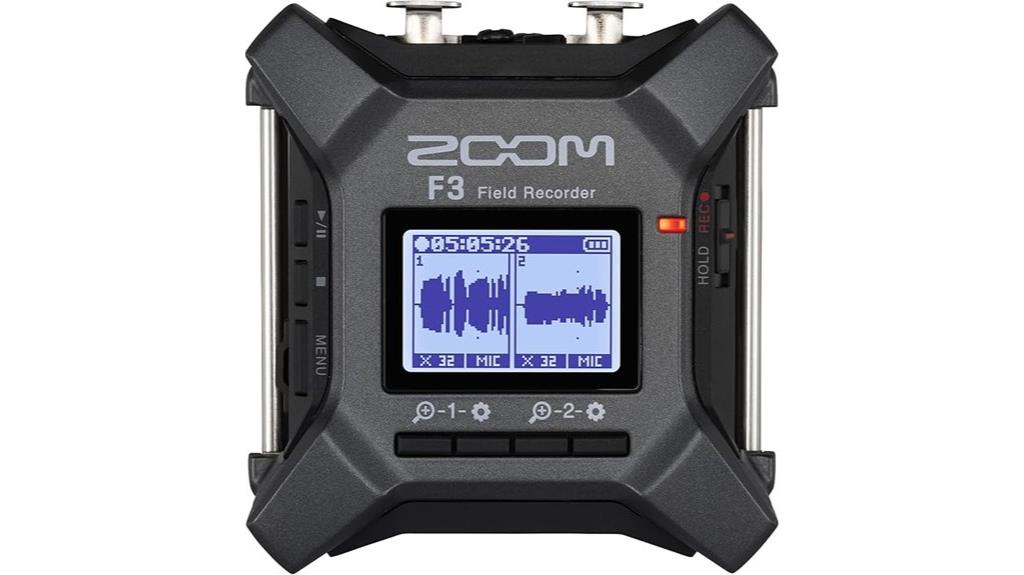
If you’re a solo operator, podcaster, or videographer seeking high-quality audio on the go, the Zoom F3 2-input field recorder is an excellent choice. This compact device features 32-bit float recording and dual AD converters, ensuring transparent sound without clipping. With two XLR inputs and over six hours of battery life, it’s perfect for extended sessions. The intuitive menus and clear display make it user-friendly, while versatile mounting options enhance its usability. I love how it seamlessly syncs with camera audio and provides phantom power for external mics, making it an invaluable tool for various recording scenarios.
Best For: Solo operators, podcasters, and videographers who need high-quality, portable audio recording solutions.
Pros:
- Compact and lightweight design makes it easy to carry and mount in various setups.
- 32-bit float recording technology ensures transparent sound capture without clipping, even at varying sound levels.
- Long battery life of over six hours allows for extended recording sessions without interruptions.
Cons:
- Lacks built-in microphones, requiring external mics, which can increase overall costs.
- No traditional gain controls may limit some users’ ability to fine-tune audio levels on the fly.
- Challenges in mounting on boom poles due to its shape, which might require additional accessories for stable attachment.
Zoom H6 Portable Recorder with 32-Bit Float
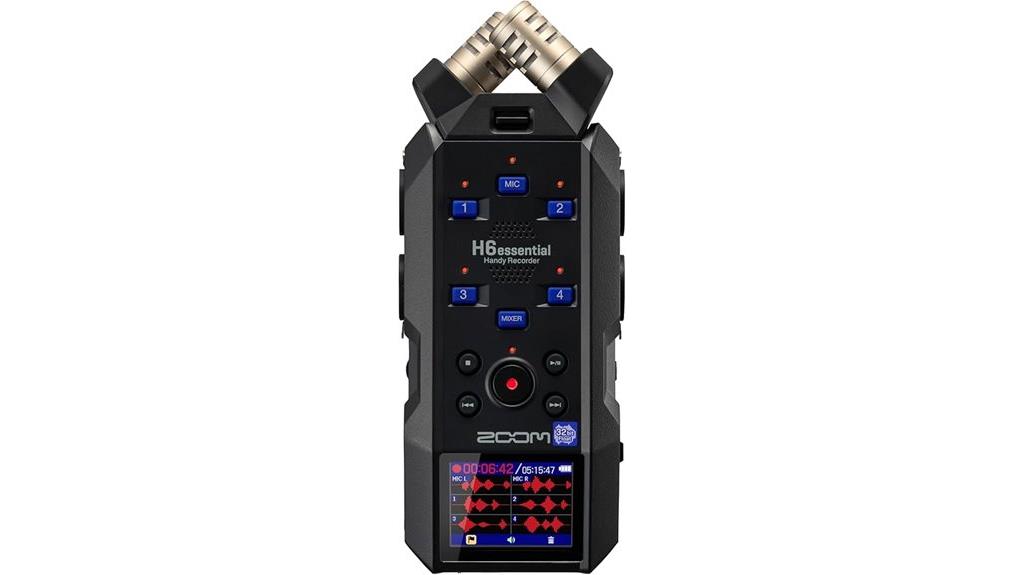
Capturing high-quality audio without the fear of clipping is a game-changer for musicians, podcasters, and filmmakers alike, and that’s exactly what the Zoom H6 Portable Recorder with 32-Bit Float delivers. With its 32-bit float recording, I can capture incredibly detailed sound without worrying about levels. The compact design makes it perfect for on-the-go use, while the four XLR/TRS combo inputs allow for versatile connections. I appreciate the intuitive interface, although there’s a slight learning curve. Overall, it’s a robust, reliable tool that’s ideal for any recording situation, providing exceptional value for both portability and sound quality.
Best For: Musicians, podcasters, and filmmakers seeking high-quality audio recording without the risk of clipping.
Pros:
- Exceptional 32-bit float recording ensures detailed sound capture without clipping issues.
- Compact and lightweight design makes it highly portable for on-the-go recording.
- Versatile connectivity options including four XLR/TRS combo inputs for various microphone setups.
Cons:
- Some users report noisy preamps and difficulties in mic level adjustments due to menu navigation.
- The file system navigation is considered outdated, with filename conventions based on date and time.
- Recording only one track can create duplicate files, wasting valuable storage space.
Zoom M4 MicTrak Audio Interface for Musicians and Podcasters

The Zoom M4 MicTrak Audio Interface stands out as an ideal choice for musicians and podcasters seeking high-quality, portable recording solutions. With its remarkable 32-bit float technology, it captures a wide dynamic range without the hassle of gain adjustments. The four-channel setup, including XLR/TRS combo inputs and an X/Y microphone capsule, ensures versatility for various recording needs. Compact and lightweight, it easily fits in my gear bag, and the battery life of up to 18 hours is a game-changer for long sessions. While some concerns about durability exist, the sound quality makes it a reliable option for professional recordings.
Best For: Musicians and podcasters looking for a portable, high-quality audio recording solution that offers advanced features without the need for extensive setup.
Pros:
- Compact and lightweight design makes it easy to transport for field recordings and multi-camera shoots.
- 32-bit float technology allows for a wide dynamic range and eliminates the need for gain adjustments.
- Long battery life of up to 18 hours enables extended recording sessions without interruption.
Cons:
- Concerns about build quality and durability due to plastic construction and fragile components.
- Some users report RF interference issues, particularly near electronic devices.
- The device does not include batteries or SD cards, which may require additional purchases for use.
Sony ICD-UX570 Digital Voice Recorder, ICDUX570BLK, usb

For anyone seeking a reliable and user-friendly recording device, the Sony ICD-UX570 Digital Voice Recorder stands out with its sleek design and impressive sound quality. Its built-in stereo microphone captures high-fidelity audio, while the enhanced sound quality guarantees every detail is heard. I love the voice-operated recording feature, which automatically starts and stops based on sound levels, making it perfect for interviews. With three versatile recording modes, I can adapt to any environment. Plus, the quick charge feature lets me record for up to an hour after just a three-minute charge. Transferring files is a breeze thanks to its USB connectivity.
Best For: Individuals seeking a portable and high-quality recording solution for interviews, lectures, or personal notes.
Pros:
- Enhanced sound quality with a built-in stereo microphone for clear recordings.
- Voice-operated recording feature allows for automatic start/stop based on sound levels.
- Quick charge capability provides up to an hour of recording with just a three-minute charge.
Cons:
- Limited battery life may require frequent charging during extended use.
- The slim design may be less durable compared to bulkier models.
- Some users may find the interface less intuitive without prior experience with digital recorders.
TASCAM DR-07XP Portable Handheld Field Recorder
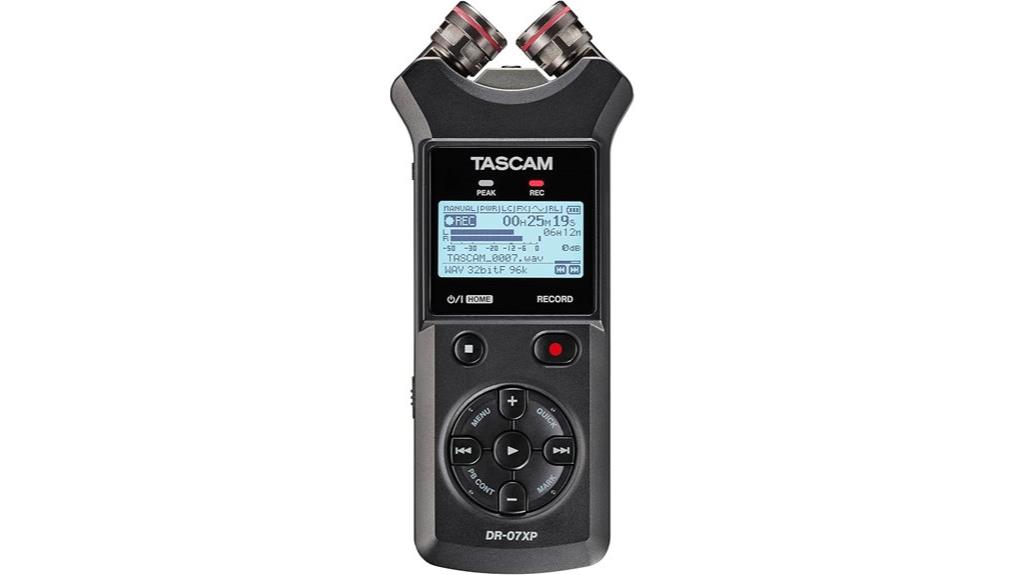
If you’re searching for a reliable and versatile field recorder, the TASCAM DR-07XP stands out with its exceptional audio quality and portability. This handheld device offers multiple recording modes, including 32-bit float and 24-bit options, making it perfect for various applications like music, podcasts, and meetings. Its stereo AB/XY microphones handle loud sounds up to 125dB SPL, ensuring clear capture even in noisy environments. Plus, with up to 17.5 hours of battery life and USB-C connectivity for direct computer recording, it fits seamlessly into my workflow. Overall, it’s a fantastic choice for anyone needing professional audio on the go.
Best For: Those seeking a portable and high-quality audio recording solution for music, podcasts, meetings, and various field applications.
Pros:
- High-quality audio capture with multiple recording modes (32-bit float, 24-bit, and 16-bit).
- Long battery life of up to 17.5 hours with 2 AA batteries.
- USB-C connectivity for easy direct recording to computers.
Cons:
- Requires separate purchase of AA batteries for operation.
- Limited to microSD card formats, which may not be compatible with all users’ existing equipment.
- Some users may find the weight (4.8 ounces) slightly heavier compared to other handheld recorders.
TASCAM Portacapture X8 32-bit 8-Channel Multitrack Field Recorder
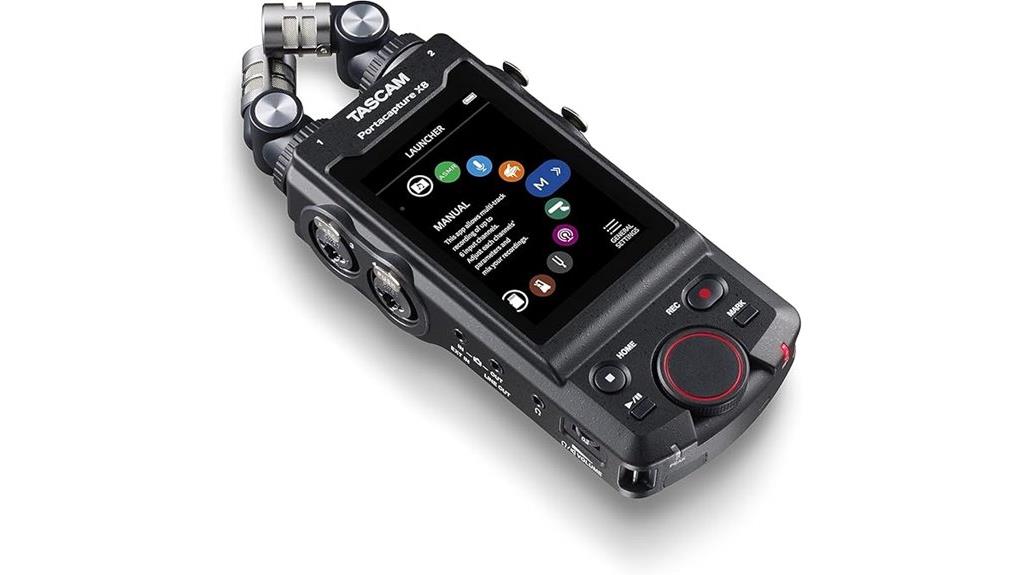
Designed with both prosumers and casual users in mind, the TASCAM Portacapture X8 32-bit 8-Channel Multitrack Field Recorder stands out for its intuitive 3.5-inch color touchscreen and versatile recording capabilities. Weighing just 1.61 pounds and measuring 9 x 7 x 3 inches, it’s perfect for on-the-go recording. With four XLR/TRS inputs and high-quality 32-bit float recording, I find it excels even in challenging environments. The Bluetooth control adds convenience, while the user-friendly interface makes setup a breeze. Whether I’m capturing interviews or music, the X8 delivers excellent sound quality, making it a reliable choice for any recording situation.
Best For: The TASCAM Portacapture X8 is best for musicians, podcasters, and field recorders looking for a versatile and high-quality multitrack recording solution.
Pros:
- User-friendly interface with a responsive touchscreen for easy navigation and setup.
- High-quality 32-bit float recording allows for capturing audio without clipping, even in loud environments.
- Bluetooth control feature enables wireless operation, enhancing convenience during recordings.
Cons:
- Plastic construction may make it less durable compared to metal-bodied alternatives.
- Limited iOS and Android OTG support, restricting compatibility with some mobile devices.
- Onboard speaker is mostly non-functional, limiting playback options without headphones.
Zoom PodTrak P4 Podcast Recorder
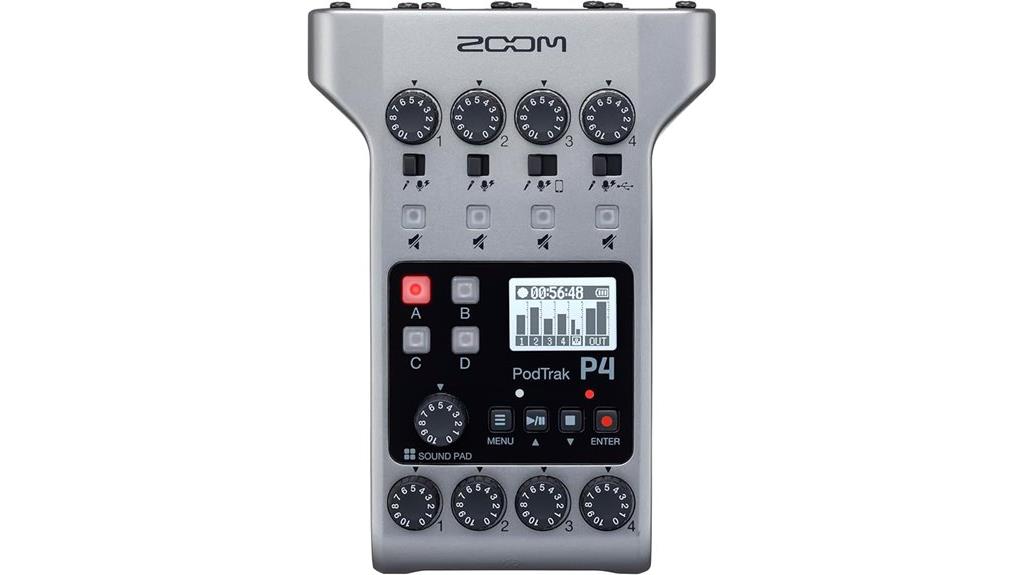
The Zoom PodTrak P4 Podcast Recorder stands out as an ideal choice for podcasters and content creators who need versatility and portability. With four high-quality microphone inputs and phantom power, I can easily record clear audio. The programmable Sound Pads add fun effects to my recordings, while multi-track recording guarantees I capture everything separately. I love the four individual headphone outputs, allowing personalized monitoring. Plus, the battery life of up to 3.5 hours on just two AA batteries is a game-changer. It’s compact, supports remote interviews, and records directly to an SD card—perfect for on-the-go recording!
Best For: Podcasters and content creators seeking a portable and versatile solution for high-quality audio recording.
Pros:
- High-quality microphone inputs with phantom power for clear audio capture.
- Compact and battery-powered design, ideal for on-the-go recording.
- Multi-track recording feature allows for separate capture of all inputs and effects.
Cons:
- Limited battery life of 3.5 hours may require frequent battery changes for longer sessions.
- Requires separate SD card for storage, which is not included.
- Some users may find the interface less intuitive for first-time users.
Zoom Digital Multitrack Recorder (F2)
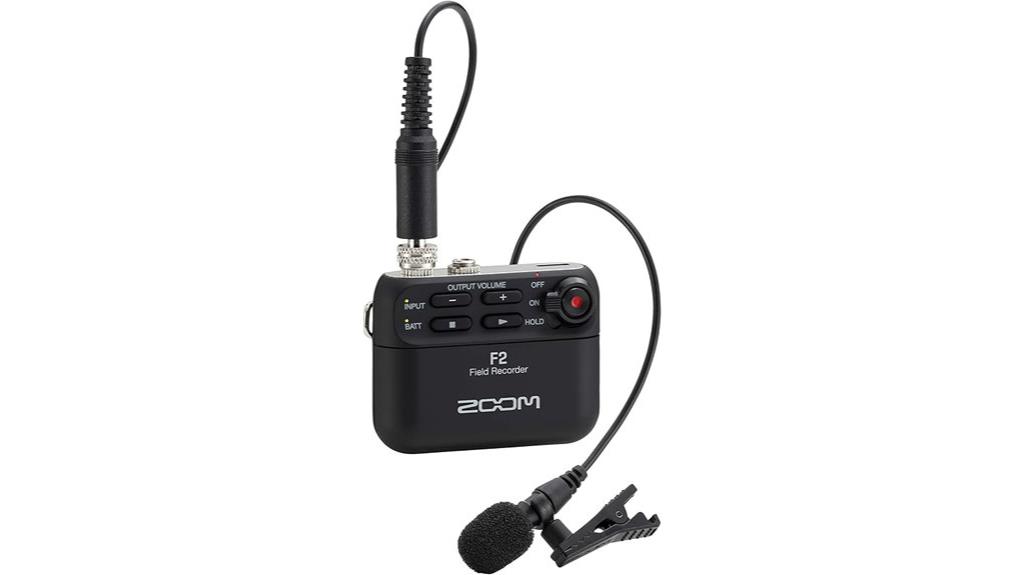
For anyone seeking high-quality audio on the go, the Zoom Digital Multitrack Recorder (F2) truly stands out. I love its 32-bit float recording, which captures pristine sound without clipping, making it perfect for professional-grade recordings. With up to 15 hours of battery life and a compact design, it’s incredibly portable. The one-touch recording feature is super user-friendly, and the low-cut filter effectively reduces unwanted noise. Plus, the lockable inputs and USB-C connectivity streamline my workflow. Whether I’m recording interviews or music, the F2 delivers clean, clear audio every time, making it an essential tool for any audio enthusiast.
Best For: The Zoom Digital Multitrack Recorder (F2) is best for audio professionals and enthusiasts who need a portable, high-quality recording solution for various environments.
Pros:
- 32-bit float recording ensures pristine audio quality without clipping.
- Compact and lightweight design makes it easy to carry for on-the-go recording.
- User-friendly features like one-touch recording and low-cut filter simplify the recording process.
Cons:
- Limited battery life with alkaline and NiMH batteries compared to lithium options.
- The lockable input may not be compatible with all microphone types.
- Some users may find the compact size less comfortable for extended use without support.
Factors to Consider When Choosing a Field Recorder Portable

When I’m choosing a portable field recorder, there are several key factors I consider. Audio quality, battery life, and portability are at the top of my list, but I also pay attention to input options and the user interface. Each of these elements plays a vital role in ensuring I get the best recording experience possible.
Audio Quality Standards
Choosing a portable field recorder requires careful consideration of audio quality standards, especially since high-resolution recordings can make a significant difference in your projects. For ideal sound, I recommend looking for a minimum of 24-bit resolution and sample rates of at least 44.1kHz. If you want even more flexibility, consider models with 32-bit float recording technology, which prevents clipping in loud environments. Omnidirectional condenser microphones are a great choice for capturing sound from all directions, ensuring natural recordings. Additionally, external microphone inputs with phantom power allow you to use professional-grade mics for enhanced fidelity. Finally, aim for recorders with low self-noise and proper gain staging to maintain consistent audio quality across your recordings.
Battery Life Considerations
While you’re out in the field capturing valuable audio, you’ll want to make certain your portable field recorder has a battery life that meets your needs. Longer battery life is essential for extended recording sessions, allowing me to focus on my work without worrying about frequent recharging or battery changes. Many devices powered by AA or rechargeable batteries provide around 10 to 20 hours of continuous use, depending on conditions. I also appreciate recorders that support external power sources like USB power banks, which give me extra flexibility. However, I keep in mind that factors such as sample rate and power-intensive features can impact battery life. Regularly monitoring the battery status helps me avoid unexpected shutdowns during critical recordings.
Portability and Weight
After ensuring that battery life meets my recording demands, I turn my attention to portability and weight, which are key factors in selecting a field recorder. I find that lightweight models, typically under 8 ounces, are much easier to carry around. Compact dimensions are essential, too, as they allow the recorder to fit in my pockets or bags without hassle. A smaller size also enhances convenience for handheld use, making for discreet recordings when needed. Additionally, I consider the battery type, as AA or rechargeable lithium-ion options can affect overall weight. finally, I look for durable designs with protective casings, ensuring my recorder can withstand environmental factors while remaining portable for my adventures.
Input Connectivity Options
When I evaluate portable field recorders, the variety of input connectivity options plays a essential role in my decision-making process. I always look for recorders with XLR inputs since they support professional-grade microphones and often include phantom power, indispensable for high-quality audio. TRS inputs are also important to me; they accommodate both microphones and instruments, providing flexibility with balanced or unbalanced signals. Additionally, I appreciate 3.5mm auxiliary inputs for quick connections to consumer-grade devices like smartphones and portable mics. The number and type of inputs can profoundly impact how many audio sources I can handle simultaneously, making this feature fundamental for my recording needs. Choosing wisely here ensures I capture the best sound possible.
User Interface Design
Choosing a portable field recorder isn’t just about sound quality; the user interface design plays a pivotal role in my overall experience. I’ve found that an intuitive interface with clear controls and menus considerably reduces the learning curve, allowing me to focus on capturing great audio. Touchscreen displays with high-contrast visuals are a game-changer, making adjustments easy, even in bright sunlight. I appreciate well-arranged physical buttons and knobs that let me operate the recorder without confusion, especially in noisy environments. Dedicated buttons for common functions streamline my workflow, and real-time feedback like level meters helps me avoid clipping, ensuring ideal audio quality. Ultimately, a user-friendly interface enhances my recording sessions and boosts my confidence as I work.
Recording Format Flexibility
While I often focus on sound quality and user interface, recording format flexibility is just as crucial when selecting a portable field recorder. I appreciate the ability to choose between various bit depths and sample rates, like 16-bit, 24-bit, or even 32-bit float, to suit different recording scenarios. Support for multiple file formats, such as WAV and MP3, ensures my recordings are compatible with editing software and distribution channels. I also value the option to switch between compressed and uncompressed formats, allowing me to balance audio quality with storage needs. With multiple recording modes like stereo or multichannel, I can capture high-fidelity sound across diverse environments, whether it’s a quiet interview or a loud live performance.
Build Quality and Durability
Having explored recording format flexibility, it’s clear that the best portable field recorder must also stand up to the rigors of the great outdoors. I always look for a rugged, weather-resistant exterior to handle unpredictable elements like rain and dust. Solid construction materials, such as metal or reinforced plastic, provide the durability I need without adding unnecessary weight. It’s vital to verify the recorder has reinforced ports and connections; frequent plugging and unplugging can lead to damage. I also pay attention to the buttons and controls, seeking high-quality feedback to withstand regular use. Finally, considering models with shock-absorbing features or protective casings can safeguard internal components during accidental drops or impacts, giving me peace of mind on my recording adventures.
Frequently Asked Questions
How Do I Choose the Right Microphone for My Field Recorder?
When choosing the right microphone for my field recorder, I consider a few key factors. First, I think about the type of sound I want to capture—whether it’s vocals, instruments, or ambient noise. I also check the microphone’s sensitivity and frequency response to guarantee it suits my needs. Finally, I look for durability, especially if I’m recording outdoors. Trust me, the right mic can make all the difference in sound quality!
Can I Connect My Field Recorder to a Smartphone?
Connecting my field recorder to a smartphone feels like opening a treasure chest of audio possibilities. Yes, you absolutely can! Most modern field recorders have the capability to link up with smartphones via USB or Bluetooth. I’ve done it myself, and it opens up a world of convenience, letting me edit and share recordings on the go. Just make sure to check compatibility, and you’ll be capturing magic in no time!
What Is the Battery Life of Portable Field Recorders?
The battery life of portable field recorders varies, but I often find they last between 4 to 20 hours, depending on usage and settings. For me, it’s essential to take into account how long I’ll be recording. Some models let me swap batteries or use USB power, which is a lifesaver during long sessions. I always carry extra batteries just in case, ensuring I don’t miss capturing any important sound moments.
Are Field Recorders Waterproof or Weather-Resistant?
Imagine standing in a downpour, capturing the rhythm of raindrops on leaves. Some field recorders are indeed waterproof or weather-resistant, but it’s essential to check the specifications. I’ve found that models designed for outdoor use often feature protective casings. While they can handle a bit of moisture, I wouldn’t recommend submerging them. Always keep them safe from extreme weather to guarantee your recordings stay crystal clear and your gear remains intact.
How Do I Transfer Recordings From a Field Recorder to a Computer?
To transfer recordings from my field recorder to my computer, I usually connect it via USB. Once it’s plugged in, my computer recognizes it as an external drive. I then browse through the files, find my recordings, and simply drag them to my desired folder on the computer. If I’m using an SD card, I just pop it into a card reader and do the same. It’s quick and easy!
Conclusion
In the world of portable field recorders, it is crucial to choose the right tool for your needs. As the saying goes, “The best tools make the job easier.” Whether you’re capturing nature sounds, interviews, or podcasting, each recorder on this list brings unique features to the table. Take your time to evaluate what fits your style, and remember that great sound is just a decision away. Happy recording!




